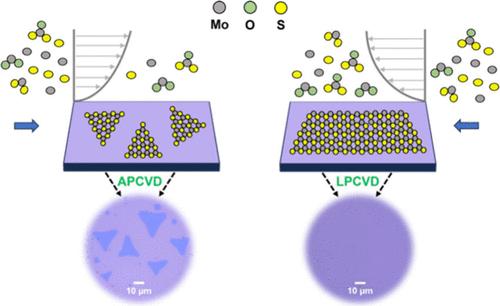探索 MoS2 的生长:大气和低压 CVD 比较研究
IF 3.9
2区 化学
Q2 CHEMISTRY, MULTIDISCIPLINARY
引用次数: 0
摘要
过渡金属二钙化物(TMD),尤其是 MoS2,因其独特的性质和潜在的应用而备受关注。化学气相沉积(CVD)通常用于合成 MoS2 的二维薄膜。MoS2 的合成对温度、压力、流速、前驱体比例等生长参数非常敏感。虽然有一些关于通过常压 CVD(APCVD)和低压 CVD(LPCVD)合成 MoS2 的报道,但缺乏对这两种方法的比较分析,而这两种方法有可能为 MoS2 的生长提供更好的视角。这项工作系统地研究了在 APCVD 和 LPCVD 条件下生长 MoS2 的情况。研究发现,MoS2 的 APCVD 生长是扩散受限的,从而导致了特征性的三角形形态,而 LPCVD 生长则是反应受限的。即使在更低的温度下(ΔT ≥ 200 °C),LPCVD 中增强的质量通量也会增加成核密度,从而形成覆盖整个基底的连续多晶薄膜。这项比较研究为理解 MoS2 的结晶和生长提供了一个更好的视角,也可以推广到其他 TMD。本文章由计算机程序翻译,如有差异,请以英文原文为准。

Exploring MoS2 Growth: A Comparative Study of Atmospheric and Low-Pressure CVD
Transition-metal dichalcogenides (TMDs), in particular MoS2, have garnered a lot of interest due to their unique properties and potential applications. Chemical vapor deposition (CVD) is generally used to synthesize 2D films of MoS2. The synthesis of MoS2 is highly sensitive to growth parameters such as temperature, pressure, flow rate, precursor ratio, etc. Though there are several accounts of MoS2 synthesis via atmospheric-pressure CVD (APCVD) and low-pressure CVD (LPCVD), there is a lack of a comparative analysis between the two methods, which could potentially offer a better perspective on the growth of MoS2. This work systematically investigates the growth of MoS2 under APCVD and LPCVD conditions. The APCVD growth of MoS2 is found to be diffusion-limited, leading to the characteristic triangular morphology, while the LPCVD growth is reaction-limited. The enhanced mass flux in LPCVD, even at much lower temperatures (ΔT ≥ 200 °C), increases the nucleation density, resulting in a continuous polycrystalline film covering the entire substrate. This comparative study provides a better insight into understanding the crystallization and growth of MoS2, which can also be extended to other TMDs.
求助全文
通过发布文献求助,成功后即可免费获取论文全文。
去求助
来源期刊

Langmuir
化学-材料科学:综合
CiteScore
6.50
自引率
10.30%
发文量
1464
审稿时长
2.1 months
期刊介绍:
Langmuir is an interdisciplinary journal publishing articles in the following subject categories:
Colloids: surfactants and self-assembly, dispersions, emulsions, foams
Interfaces: adsorption, reactions, films, forces
Biological Interfaces: biocolloids, biomolecular and biomimetic materials
Materials: nano- and mesostructured materials, polymers, gels, liquid crystals
Electrochemistry: interfacial charge transfer, charge transport, electrocatalysis, electrokinetic phenomena, bioelectrochemistry
Devices and Applications: sensors, fluidics, patterning, catalysis, photonic crystals
However, when high-impact, original work is submitted that does not fit within the above categories, decisions to accept or decline such papers will be based on one criteria: What Would Irving Do?
Langmuir ranks #2 in citations out of 136 journals in the category of Physical Chemistry with 113,157 total citations. The journal received an Impact Factor of 4.384*.
This journal is also indexed in the categories of Materials Science (ranked #1) and Multidisciplinary Chemistry (ranked #5).
 求助内容:
求助内容: 应助结果提醒方式:
应助结果提醒方式:


